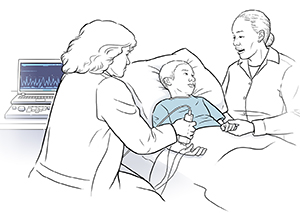A
B
C
D
E
F
G
H
I
J
K
L
M
N
O
P
Q
R
S
T
U
V
W
X
Y
Z
Topic IndexLibrary Index
Click a letter to see a list of conditions beginning with that letter.
Click 'Topic Index' to return to the index for the current topic.
Click 'Library Index' to return to the listing of all topics.
Your Child's Electromyogram and Nerve Conduction Study
An electromyogram (EMG) and a nerve conduction study (NCS) are tests that check peripheral muscle and nerve function. The tests are often done together, but sometimes only one test is done. During an NCS, small, round discs with wires (electrodes) are placed on the skin along pathways of certain nerves. The electrodes record how quickly the muscles and nerves respond to an electrical stimulus. During an EMG, small needle electrodes are placed in different muscles in the arms or legs. The electrical activity of the muscles is then recorded as your child rests and tightens the muscles. The tests often take about 60 minutes.
 |
| These tests check the electrical activity along certain muscles and nerves. |
Before the tests
Follow all instructions given by your child’s healthcare provider to prepare your child for the test. For some children, the provider may prescribe a mild sedative before the test.
Note
For your safety and best results, tell the healthcare provider if your child:
-
Takes any medicines, especially aspirin or blood-thinning medicines
-
Has any health problems, most specifically if your child has a pacemaker (this doesn't mean that the test shouldn't be done, but it should be cleared with your cardiologist before starting the exam)
During the tests
An EMG and NCS are often done by a trained technologist or healthcare provider. You can stay in the room with your child. Your child may bring along a favorite toy, such as a stuffed animal, for comfort.
-
Your child changes into a hospital gown and lies on a hospital bed.
-
The NCS is most often done first. During an NCS:
-
The technologist cleanses the skin of the areas being tested.
-
Then the sterile electrodes are placed on the skin. In some cases, gel is first applied to the skin to improve the signals. Tape may be used to help keep the electrodes in place.
-
The technologist controls a stimulator, which sends mild electrical currents to certain electrodes. The electrical currents are safe. But there could be some minor discomfort. They are used to stimulate the nerves under the electrodes. This may cause the muscles in these areas to twitch or tingle.
-
The electrical activity of the nerves is then recorded.
-
Once the NCS is done, the EMG begins. During an EMG:
-
The technologist cleanses the skin of the areas being tested.
-
Sterile needle electrodes are then placed into the muscles of these areas. When the needle electrode is inserted, your child may feel as though they are being pinched.
-
Your child is asked to relax. This is so the technologist can record the electrical activity of the muscles at rest.
-
Then your child is asked to tighten the muscles. This is so the technologist can record the electrical activity of the muscles when they are active.
-
The needle electrodes may be moved a few times to test the electrical activity in different muscle areas. Once the EMG is done, they are removed.
After the tests
Here is what you can expect:
Helping your child get ready
Many hospitals have people trained in helping children cope with their medical care or hospital experience. These people are often called child life specialists. Check with your child’s healthcare provider if child life programs or other services like this are available for your child. There are also things you can do to help your child get ready for a test or procedure. The best way to do this depends on your child’s needs. Start with the tips below:
-
Use brief and simple terms to describe the test to your child and why it’s being done. Younger children tend to have a short attention span, so do this shortly before the test. Older children can be given more details and time to understand the test in advance.
-
Tell your child what to expect in the hospital during the test. For instance, you could tell them who will be doing the test. Or talk about what the room will look like where the procedure will take place.
-
Make sure your child knows which body parts will be involved in the test.
-
As best you can, describe how the test will feel. For instance, an electrode may be placed on the skin. The electrode is round and may feel sticky.
-
Allow your child to ask questions and answer the questions truthfully. Your child may feel nervous or afraid. They may even cry. Let your child know that you’ll be nearby during the test.
-
Use play when telling your child about the test, if appropriate. With younger children, this can include role-playing with a child’s favorite toy or object. With older children, it may help to read books or show pictures of what happens during the test.
Online Medical Reviewer:
Dan Brennan MD
Online Medical Reviewer:
Joseph Campellone MD
Online Medical Reviewer:
Raymond Kent Turley BSN MSN RN
Date Last Reviewed:
12/1/2022
© 2000-2025 The StayWell Company, LLC. All rights reserved. This information is not intended as a substitute for professional medical care. Always follow your healthcare professional's instructions.